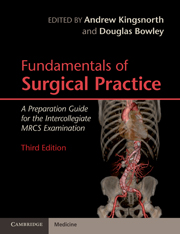Book contents
- Frontmatter
- Contents
- List of contributors
- Preface
- Section 1 Basic Sciences Relevant to Surgical Practice
- 1 Pharmacology and the safe prescribing of drugs
- 2 Fundamentals of general pathology
- 3 Fundamentals of surgical microbiology
- 4 Fundamentals of radiology
- Section 2 Basic Surgical Skills
- Section 3 The Assessment and Management of the Surgical Patient
- Section 4 Perioperative Care of the Surgical Patient
- Section 5 Common Surgical Conditions
- Index
- References
1 - Pharmacology and the safe prescribing of drugs
Published online by Cambridge University Press: 03 May 2011
- Frontmatter
- Contents
- List of contributors
- Preface
- Section 1 Basic Sciences Relevant to Surgical Practice
- 1 Pharmacology and the safe prescribing of drugs
- 2 Fundamentals of general pathology
- 3 Fundamentals of surgical microbiology
- 4 Fundamentals of radiology
- Section 2 Basic Surgical Skills
- Section 3 The Assessment and Management of the Surgical Patient
- Section 4 Perioperative Care of the Surgical Patient
- Section 5 Common Surgical Conditions
- Index
- References
Summary
Understanding the pharmacological principles and safe use of drugs is just as important in surgical practice as in any other medical specialty. With an ageing population with often multiple comorbidities and medications, as well as an expanding list of new pharmacological treatments, it is important that surgeons understand the implications of therapeutic drugs on their daily practice. The increasing emphasis on high quality and safe patient care demands that doctors are aware of preventable adverse drug reactions (ADRs) and interactions, try to minimize the potential for medication errors, and consider the benefits and harms of medicines in their patients. This chapter examines these aspects from the view of surgical practice and expands on the implications of some of the most common medical conditions and drug classes in the perioperative period.
The therapeutic care of surgical patients is obvious in many circumstances – for example, antibacterial prophylaxis, thromboprophylaxis, and postoperative analgesia. However, the careful examination of other drug therapies is often critical not only to the sustained treatment of the associated medical conditions but to the perioperative outcomes of patients undergoing surgery. The benefit–harm balance of many therapies may be fundamentally altered by the stress of an operation in one direction or the other; this is not a decision that should wait until the anaesthetist arrives for a preoperative assessment or one that should be left to junior medical or nursing staff on the ward.
- Type
- Chapter
- Information
- Fundamentals of Surgical PracticeA Preparation Guide for the Intercollegiate MRCS Examination, pp. 1 - 14Publisher: Cambridge University PressPrint publication year: 2011

